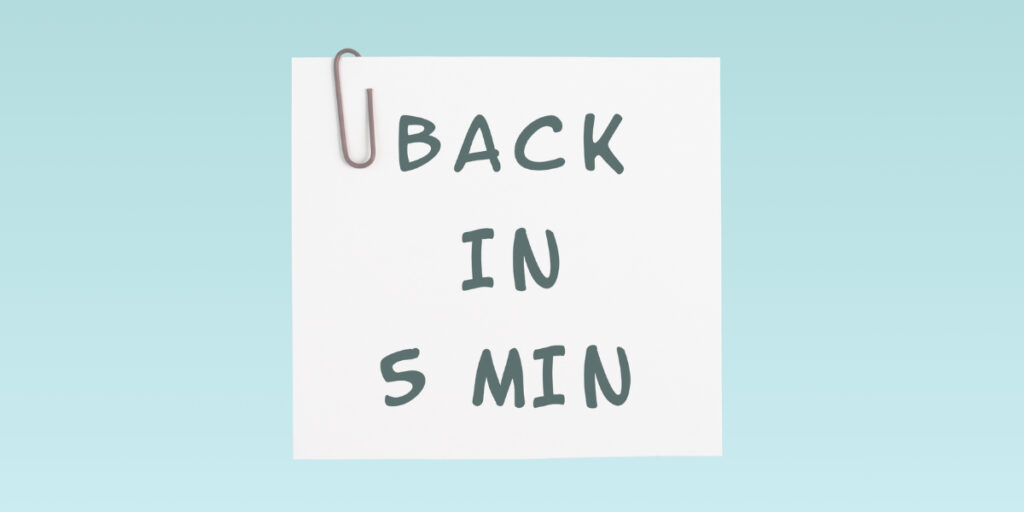
Smooth transitions during the workday can boost credibility and rapport. If you’ve ever needed to slip out of a meeting or leave a group project briefly, you know excusing yourself at work requires more than just walking away. It signals self-awareness and respect for others’ time and focus.
Polite exits protect relationships and ensure teams stay on track. Even a small interruption can ripple through a group dynamic. That’s why the skill of excusing yourself at work quietly yet effectively pays dividends, especially when client calls run long or coworkers need undisturbed focus.
Let’s explore how tactful language and mindful presence help you exit or pause interactions smoothly. Below you’ll find actionable scripts, step-by-step examples, and nuanced tips specific to a variety of professional settings. Try these in your next meeting.
Strategically Announcing Your Departure Prevents Miscommunication
Offering a clear, concise reason for leaving keeps everyone informed and minimizes confusion. Demonstrating respect for colleagues reduces disruption, paving the way for smoother workflow. It also reflects positively on your professionalism and collaborative approach.
Whether you’re excusing yourself at work to handle a call or stepping out for an urgent matter, use direct statements. Say, “Excuse me, I need to take a call regarding this project. I’ll return in five minutes.” Specific details prevent speculation and underscore responsibility.
Modeling Direct Communication Sets the Right Tone
Directness, paired with a polite tone, shows respect and confidence. For example, tell your team, “I apologize for stepping out—I’ll catch up right after.” Eye contact and a gentle nod signal commitment to return and maintain workflow momentum.
Try comparing the impact of “I’ll be right back” versus “I have a quick personal call, and I’ll rejoin in ten minutes.” The second script fosters trust and helps colleagues plan accordingly. People appreciate transparency, not vague promises.
Analogous to signaling when exiting a highway, a well-timed announcement avoids abrupt stops that could cause confusion. Think of each interaction as traffic—signal before shifting gears.
Scripts for Different Scenarios: Meetings, Desks, and Networking
For meetings, saying, “Pardon me, I need to step out to address an urgent matter. Please continue, and I’ll review notes later,” works well. At your desk, you might state, “Excuse me, I’ll be away briefly to update a client.”
During a networking event, try, “This conversation has been great. May I circle back with you after I greet a colleague?” These short scripts validate others’ time and make it easier to resume conversations later if needed.
Use body language to underscore your intent: gather your belongings calmly, avoid rushed movements, and offer a friendly smile as you exit. Consistency in approach breeds familiarity and reduces awkwardness.
| Situation | Suggested Phrase | Nonverbal Cue | Key Takeaway |
|---|---|---|---|
| Internal Meeting | “Excuse me, I need to handle a quick call.” | Smile, soft wave | Brief, clear statement keeps flow intact. |
| One-on-One | “Do you mind if I pause to run an errand?” | Direct eye contact | Personal respect encourages understanding. |
| Networking | “Can I reconnect right after I greet someone?” | Handshake, gentle nod | Keeps relationships warm for follow-up. |
| Open Workspace | “I’ll step out for a moment—back in five.” | Gather materials calmly | Minimizes distraction, confirms intent. |
| Virtual Meeting | “I need to mute briefly for a call, back soon.” | Camera off with message in chat | Professional courtesy maintains engagement. |
Crafting Your Exit: Words and Actions That Leave a Positive Impression
Choosing respectful phrases makes your exit memorable for the right reasons. Tailoring your language to fit the environment—casual or formal—matters. Practice balancing personal needs with collective priorities, especially during excusing yourself at work for private matters.
Add a positive note, like “Thank you for understanding.” It shows appreciation without lingering. Exiting gracefully means you’re more likely to be welcomed back into the conversation without awkwardness or missed context.
Gauging Timing and Tone
Assess the conversation’s intensity before interjecting. Steps: wait for a pause, use a calm, steady voice, and avoid cutting off the speaker. This approach demonstrates both patience and respect for others’ contributions.
- Decide if your absence disrupts outcomes to minimize impact; wait until a discussion point completes for smoother transitions.
- Choose words: “If I may, I’ll step out for a few minutes.” Clear intention prevents misunderstandings about your return.
- Breathe before excusing to ground your voice—showing poise reduces distraction and reassures others you’re not leaving abruptly.
- Plan ahead if there’s a predictable exit, like back-to-back meetings. Inform those involved early for a seamless handover or follow-up.
- Smile and express gratitude while leaving. Positive energy keeps morale high and signals genuine appreciation for collaborators’ flexibility.
Even small gestures signal you intend to return promptly and resume your commitment to the team’s goals, looping everyone in smoothly.
Making a Professional Return
When you rejoin, reference what may have transpired in your absence: “Thanks for patience—can I get a recap?” This script acknowledges group effort and helps you catch up efficiently.
- Re-enter quietly, greeting with a friendly nod to avoid further disruption. This keeps the group focused on the work at hand.
- Confirm your awareness of any misses: “Sorry for stepping out. Anything I should catch up on?”
- Follow up one-on-one afterward if needed. This proactive step ensures you build trust while maintaining continuity in task flow.
- Document missed action items if applicable, sharing your willingness to contribute despite your brief absence.
- Express appreciation for others’ flexibility, cementing your reputation as respectful and considerate within group dynamics.
Excusing yourself at work elegantly isn’t just about leaving—it’s about making reintegration smooth and unintrusive for others.
Managing Exits in Different Workplace Settings to Respect Team Productivity
Context shapes the approach—leaving a cubicle, remote workspace, or conference room each requires nuanced behavior. Being attuned to your environment ensures efficiency and strengthens peer perceptions of your professionalism and communication skills.
Small gestures, like muting devices before stepping out or adding a calendar note for departures, prevent disruptions and provide transparency for team coordination. These details help foster positive group habits around excusing yourself at work.
Tailoring Your Exit in Quiet Workspaces
Leaving a silent office means moving gently, speaking softly, and minimizing rustling. Pack up quietly, stand slowly, and if needed, whisper a low-key “Excuse me, I’ll be right back” to neighbors.
Refrain from tapping colleagues on the shoulder or broadcasting your exit. Instead, leave a subtle note on your desk or a quick message in a communal chat for transparency. This preserves others’ concentration.
When returning, a soft smile or brief nod reassures colleagues you’re back. Avoid launching into conversation or breaking the silent flow until you gauge readiness from those around you.
Remote and Hybrid Meeting Exits
Online settings require clarity and proactive communication. Let hosts know in advance if you might leave by typing, “Need to step out at 2:50 for a call.” Mute before exiting, and add a return time in chat.
Turn off your camera briefly, post a status update, or use in-app tools to signal “brb.” Upon returning, acknowledge your absence verbally or in the chat to maintain rapport with the group remotely.
Remote etiquette reflects trust in your accountability. These habits set clear expectations and help solidify team trust around excusing yourself at work, regardless of where everyone is physically located.
Role-Specific Approaches: Managers, Team Members, and Administrative Staff
Managers, team members, and administrative staff might excuse themselves differently, each adapting language and behavior based on authority and responsibility. Each approach focuses on minimizing workflow disruption, supporting collaborative culture, and modeling professional boundaries.
Managers can model concise exits by stating, “Excuse me, I’ll check with HR and return with an answer,” reinforcing leadership and proactive problem-solving while providing clarity on next steps.
Team Member Scripts and Scenarios
When you’re not leading, always acknowledge supervisors’ or project leads’ authority. Use phrases like, “Is this a good time to step out for a call?” to show regard for structure and timing.
Convey respect by following up on your return: “Anything I missed while away?” This reassures the group of your dedication and willingness to remain engaged and caught up.
Adjust language for informal teams: a casual, “Back in five—text me if you need anything,” signals both availability and respect for team preferences around excusing yourself at work.
Administrative and Support Roles
Support staff can flag brief departures with sticky notes: “Stepping out, back at 11:15.” This keeps operations running and provides a clear return window for those seeking in-person support.
Verbal messages—“I’ll be away from my desk for a few minutes to assist another department”—offer transparency and prevent confusion, especially in front-facing roles with frequent drop-in guests.
Follow up by sending a recap email if you missed any important interactions. This closes the communication loop and ensures no service interruptions.
Scripts and Gestures for Navigating Sensitive or Unexpected Departures

Sometimes, emergencies or private matters arise without warning. Using calm and authentic language—like, “I have to step out for something urgent, I’ll be back as soon as possible”—signals professionalism even under pressure.
Gestures matter as much as words here: purposeful yet unrushed movements, a brief apology under your breath, and a polite exit all communicate that you value your colleagues’ time and focus.
When Health or Family Matters Prompt a Quick Exit
Say, “Sorry, I need to address a health issue, but I’ll follow up once I’m able.” This reassures others while setting expectations for your return and follow-up actions.
After stepping out, keep your team updated when possible. A quick text—“Still away, back on task at noon”—demonstrates accountability without revealing private details.
Transparency paired with discretion creates a balance between personal privacy and workplace harmony, an essential skill for confidently excusing yourself at work in unpredictable scenarios.
Unanticipated Client or Leadership Requests
For last-minute demands, say, “I’m needed urgently by [client/manager]. I’ll update you as soon as I return.” This clear notice helps teammates reset their expectations without feeling left behind.
Upon your return, take initiative to brief affected colleagues. Offer, “Here’s what happened while I was away,” then reconnect with workflow priorities so group productivity doesn’t stall.
These immediate, solution-oriented steps reinforce your reliability and strengthen your reputation for maturity and communication under pressure.
Consistent Courtesy Yields Long-Term Benefits
Excusing yourself at work, done thoughtfully, supports efficient collaboration and keeps teams running smoothly. Each situation benefits from tailored language, timing, and gestures that validate colleagues’ time and focus, fostering trust and camaraderie.
These strategies empower you to balance personal priorities with group goals. The habit of transparent exits leads to fewer misunderstandings and sets a tone of mutual respect, whether during high-stakes client meetings or daily routine moments.
Start with clear, polite phrasing and adapt your approach to fit each context. By making each exit and return intentional, you reinforce a respectful culture and contribute to a more harmonious, productive workplace for everyone.
Frequently Asked Questions
What’s a respectful way to leave a recurring meeting early?
Politely announce your need to leave ahead of time. For example, say, “I have a scheduling conflict and will need to leave this meeting at 2:45, but I’ll review the notes and follow up by email.”
How can I excuse myself during a busy open office environment?
Use concise scripts like, “Stepping out for a client call, back in ten.” Leave a visible note or update your work chat status so others can see your return time, maintaining transparency without disrupting the flow.
What if I suddenly feel unwell in a team setting?
Quietly excuse yourself with a simple, “I need a moment due to health reasons, I’ll follow up when I’m back.” Afterward, update your team or supervisor via message or chat, ensuring everyone knows you’ll reconnect soon.
Should I explain my reason for leaving every time?
Offer just enough detail to clarify the situation. For recurring exits, a brief, “I’ll be away for a personal matter,” suffices. This sets polite boundaries without oversharing, keeping the interaction professional and efficient.
How do I rejoin a conversation or meeting seamlessly?
Return quietly and express thanks: “Thanks for your patience, can I get a quick update?” This script signals readiness to reengage, respects others’ time, and helps you quickly catch up without interrupting the group’s focus.

Open-Office Etiquette: Staying Considerate
Learn actionable open office etiquette that keeps your workspace focused and friendly.

